Chinese Dynasty: Ming Dynasty’s Rise and Golden Era
The Ming Dynasty (明朝, Míng, 1368-1644) was one of the great dynasties in Chinese history, ruling China for over 250 years. It was established after the Mongol Yuan Dynasty (元朝) was overthrown by Zhu Yuanzhang (朱元璋), who became known as the Hongwu Emperor (洪武帝). The Ming Dynasty represented a new era of strong Chinese rule after Mongol domination and saw immense growth in economy, culture, and technology.
Establishment of the Ming Dynasty
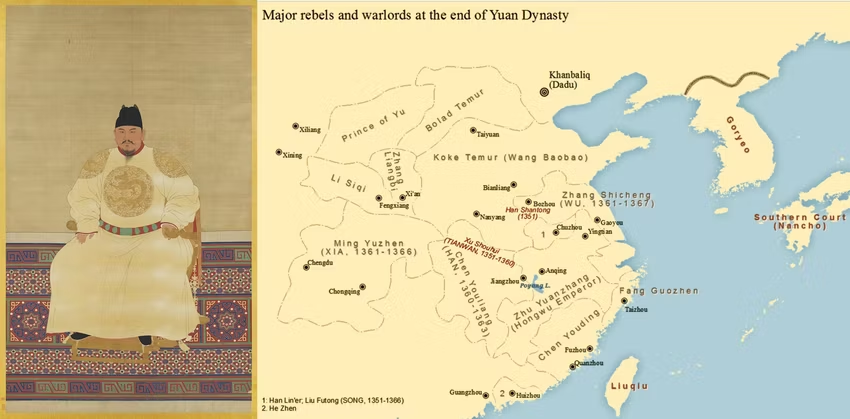
Portrait of the Hongwu Emperor (left) and major rebels and warlords at the end of the Yuan Dynasty (right)
In the late Yuan Dynasty, the government was corrupt, and the nobility was extravagant. Peasant rebellions erupted, led by Red Turbans (红巾军).
Zhu Yuanzhang was born into a poor peasant family and later became a Buddhist monk to survive. In 1352, he joined the Red Turban Army led by Guo Zixing (郭子兴). Zhu Yuanzhang displayed bravery and intelligence in battles, and quickly earned Guo Zixing's appreciation, who considered him a close confidant and married his adopted daughter, Lady Ma, to Zhu Yuanzhang.
Zhu Yuanzhang rapidly gained influence in the army and led his own forces. His rebel army was disciplined, appointed based on merit, and gradually expanded its power. In 1356, Zhu Yuanzhang captured Jiqing (集庆, present-day Nanjing, 南京), and expanded his control. He adopted the strategy of "building high walls, accumulating abundant provisions, and delaying the declaration of kingship" (高筑墙,广积粮,缓称王). After several years of effort, both his military and economic strength grew rapidly.
Despite commanding a hundred thousand troops, Zhu Yuanzhang still held a relatively small territory and faced enemies on all sides. In 1363, Zhu achieved a decisive victory in the Battle of Lake Poyang (鄱阳湖之战), defeating Chen Youliang (陈友谅) and seizing control of southern China. The Battle of Lake Poyang was the largest naval battle in medieval China. In 1364, Zhu Yuanzhang proclaimed himself King of Wu (吴王), laying the foundation for his political power known as West Wu (西吴). In 1367, Zhu conquered Pingjiang (平江) and Zhang Shicheng (张士诚) took his own life. In the same year, Fang Guozhen (方国珍), who controlled the coastal areas of Zhejiang, surrendered.
In January 1368, Zhu Yuanzhang declared himself emperor in Nanjing, taking the title of Ming Taizu (明太祖) and establishing the Ming Dynasty. Later in August, he captured the Yuan capital, Dadu (大都, present-day Beijing, 北京), and the Yuan court retreated to the north, known as the Northern Yuan (北元), marking the end of the Yuan Dynasty in the central plains.
In 1371 and 1381, Zhu Yuanzhang eliminated forces in Sichuan (四川) and Yunnan (云南), respectively. In 1372 and 1388, he launched two expeditions into northern Mongolia, inflicting heavy blows on the Northern Yuan. Thus, the unification of the country was largely achieved during this period.
Reign of Hongwu
During the early establishment of the Ming Dynasty, the founding emperor, Zhu Yuanzhang (or the Hongwu Emperor, 洪武帝, reigned 1368-1398), initially adhered to the administrative system of the Yuan Dynasty, where the chancellor of the Zhongshu Sheng (中书省, or Central Secretariat) was responsible for central government affairs. Zhongshu Sheng served as an institution to assist the emperor in handling political matters.
As the influence of the Yuan receded to the north, securing the overall victory for the Ming, the Hongwu Emperor's governance strategy gradually evolved. In order to strengthen imperial authority and curb the power of chancellors, he abolished Zhongshu Sheng and the position of chancellor, personally taking control of the six ministries (六部) to enhance imperial power. He also selected several literati for assistance and acting as advisers.
Hongwu implemented a system of feudal land grants, dispatching his descendants to strategic locations as regional rulers, following the principle of "guarding the borders externally and relying on internal support" (外卫边陲,内资夹辅). He also established the Weisuo (卫所) system, with military command authority firmly controlled by the central government.
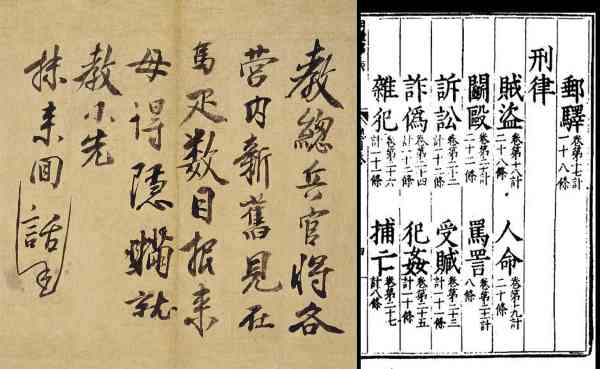
True traces of Zhu Yuanzhang's calligraphy (left) and a page from the Da Ming Lü,《大明律》(right)
Born into poverty and victimized by corrupt officials, Zhu Yuanzhang, influenced by the political chaos of the Yuan Dynasty, adopted a vigorous approach to governance. Recognizing the role of law in governing the country, he initiated a nationwide campaign against corrupt officials upon ascending the throne, targeting officials at all levels from the central government to local authorities.
In 1373, the Minister of Justice, Liu Weiqian (刘惟谦), compiled the Da Ming Lü (《大明律》, "Great Ming Code") under Hongwu's guidance, which was officially promulgated in 1397 after three revisions.
Hongwu also implemented policies of light taxation and reduced levies to revive social production. He encouraged farmers to return to cultivation, rewarded the reclaiming of land, and promoted the cultivation of new lands. Using compulsory measures, he relocated farmers from densely populated areas to sparsely populated ones. For those engaged in land reclamation, the government provided oxen, agricultural tools, and seeds, with a three-year tax exemption for the reclaimed landowners. Hongwu also organized farmers across the country to improve water conservancy and vigorously promoted the cultivation of economic crops such as silk, hemp, cotton, and fruit trees. He also aimed to enrich the people, restrain the powerful, emancipate slaves, reduce taxes, punish corrupt officials, and conduct surveys nationwide to measure land and assess household populations.
After pacifying the realm, the Hongwu Emperor rewarded his meritorious subjects, but he also harbored suspicions towards them.
In 1380, on charges of abuse of power and miscarriage of justice, Hongwu executed Hu Weiyong (胡惟庸) and other officials, abolished Zhongshu Sheng, and discontinued the position of chancellor. In 1390, Li Shanchang (李善长) was sentenced to death, with over seventy of his family members meeting the same fate, resulting in the overall execution of more than thirty thousand people. Subsequently, Hongwu, under the pretext of suppressing the unruly behavior of General Lan Yu (蓝玉), carried out extensive purges, leading to the extermination of more than fifteen thousand individuals. The cases of Hu Weiyong and Lan Yu were among the Four Major Cases of the early Ming Dynasty (明初四大案).
Through actions such as suppressing meritorious officials and establishing the Jinyiwei (锦衣卫, Embroidered Uniform Guard) to strengthen surveillance, the Hongwu Emperor consolidated imperial power, resulting in several purges during the early Ming. This laid the groundwork for the complex power dynamics that would shape the Ming Dynasty's future.
Yongle Emperor and the Early Ming Expansion
In 1398, the Hongwu Emperor passed away, and his grandson Zhu Yunwen (朱允炆) ascended the throne as the Jianwen Emperor (建文帝, reigned 1398-1402). To consolidate central authority, Jianwen conspired with trusted ministers to weaken the power of regional princes. Many princes were either deposed or forced to commit suicide. Prince of Yan (燕王) Zhu Di (朱棣) rebelled, and after a three-year war for the throne, he eventually captured the capital (present-day Nanjing) and won the conflict known as the Jingnan Campaign (靖难之役). The Jianwen Emperor's fate remained unknown amid a great fire in the palace. In 1402, Zhu Di assumed the throne as the Yongle Emperor (永乐帝, reigned 1402-1424).
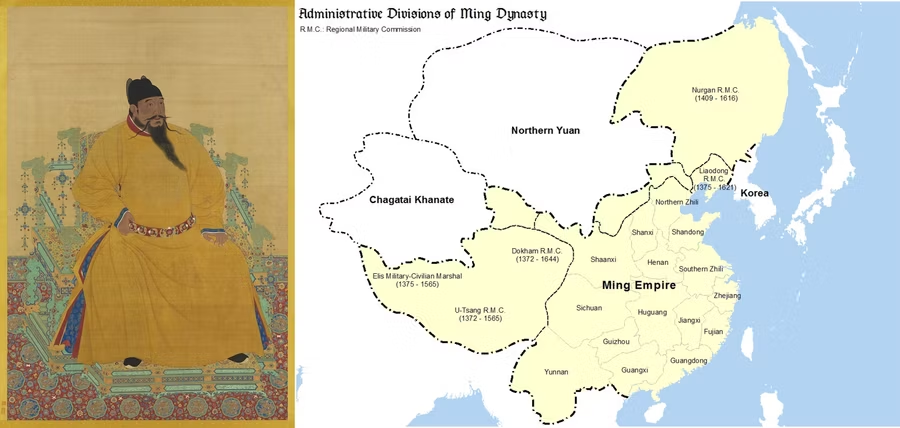
Left: a portrait of the Yongle Emperor. Right: the Ming Empire during the Yongle Emperor's reign (as of 1409).
Upon ascending the throne, the Yongle Emperor harshly suppressed dissenters and continued to strengthen central authority. He reformed the bureaucratic structure, improving the civil service system, and laying the foundation for the later development of the cabinet system. He appointed seven scholars to senior positions in the Hanlin Academy (翰林院), making them the primary advisors for state affairs. Additionally, alongside Jinyiwei (锦衣卫), he established a new spy agency called the Dongchang (东厂, Eastern Depot). To enhance control over the northern regions, Yongle relocated the capital from Nanjing to Beijing in 1403, demoting Nanjing to a secondary position. Construction of the new capital lasted from 1407 to 1420. The Imperial City, with the Forbidden City (紫禁城) at its core, served as the political center.
During the reign of the Yongle Emperor, the territory of Ming expanded. In the northern regions, Yongle personally led five expeditions to the remnants of the Northern Yuan (北元). In the southern regions, Yongle launched campaigns against Annam (安南), incorporating it into the Ming Empire. However, Annam regained independence during the reign of the Xuande Emperor (宣德帝).
The Yongle Emperor sought to pacify various Jurchen tribes in the northeast and further expand Ming's territory. In the southwest, he exploited local conflicts and took control of the Guizhou (贵州) region while strengthening development in Yunnan (云南). Additionally, Yongle granted numerous titles in the Tibetan region to enhance Ming's control over Tibet.
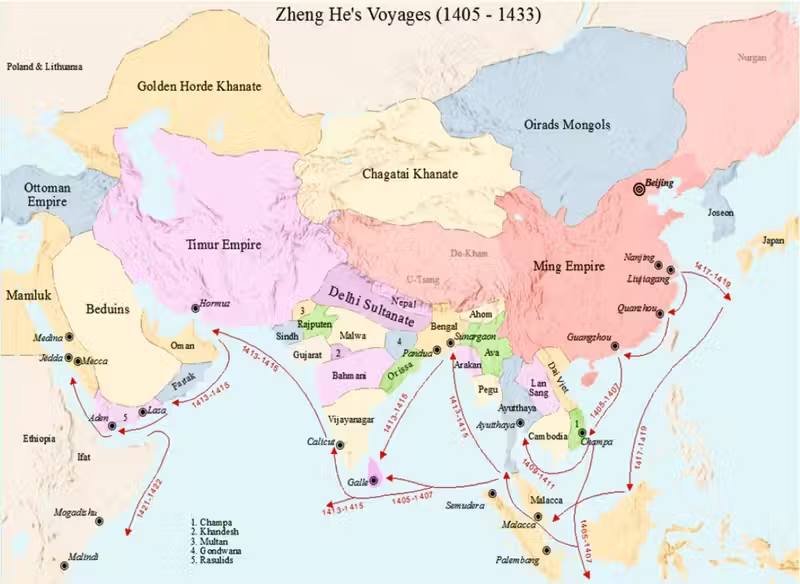
Voyages of Zheng He
Starting from 1405, the Yongle Emperor dispatched the eunuch Zheng He (郑和) on several maritime expeditions to the west. Zheng He's fleet traversed Southeast Asia and South Asia, establishing bases. The scale of these expeditions was unprecedented, reaching as far as East Africa, specifically the Somali region, thereby expanding the Ming's influence over various countries in the Indian Ocean and the South China Sea.
Yongle also focused on social and economic recovery and development. He vigorously developed and improved the military garrison-farming system and established policies for salt merchants, ensuring a stable supply of military provisions and border funds. He took measures to manage water resources in Jiangnan. In the central plains, he encouraged the cultivation of idle lands and implemented methods like relocating people and overseeing farming to boost production. Additionally, he implemented relief measures to prevent farmer bankruptcies, ensuring the stability of taxation and conscription. These initiatives led to a peak in prosperity during the Yongle era, with abundant revenue.
Additionally, Yongle promoted a literary government during his reign. In 1403, he ordered scholars to collect and categorize books from all over the country eventually resulting in a comprehensive work named Yongle Encyclopedia (《永乐大典》) in 1408.
The Peak of Ming's Rule
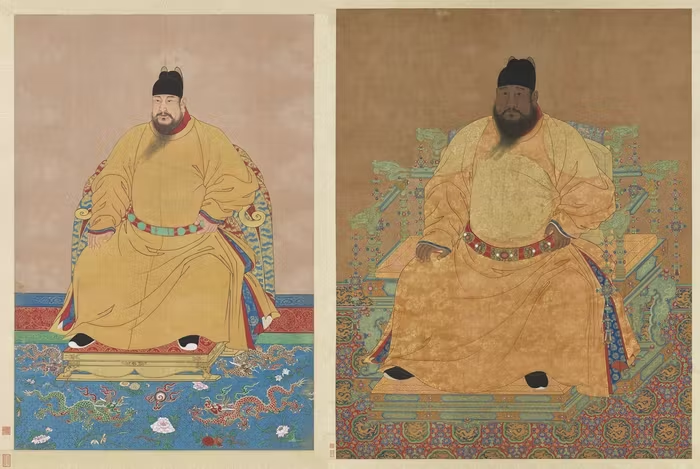
Portraits of the Hongxi (left) and Xuande (right) Emperors
After the death of the Yongle Emperor, his eldest son the Hongxi Emperor (洪熙帝, reigned 1424-1425) ascended to the throne. With considerable political experience, the Hongxi Emperor initiated a series of reforms upon his coronation, including rectifying wrongful imprisonments and sentences during the Yongle era. This led to the redress of numerous unjust cases and the restoration of some high-ranking officials' positions, easing internal conflicts within the ruling group.
Politically, the Hongxi Emperor appointed capable ministers to assist in governance. He departed from the tyrannical rule of the Yongle era, praising outspokenness, and embracing advice, and although with some limitations, he made significant progress compared to the preceding era. In military matters, Hongxi reorganized military preparations, discontinuing the large-scale military campaigns of the Yongle period. However, due to his advanced age, he passed away just one year into his reign.
Hongxi's eldest son the Xuande Emperor (宣德帝, reigned 1425-1435) ascended to the throne. Building upon his father's foundations, Xuande established a stable ruling core with a focus on preserving achievements. After resolving lingering issues from the previous reign, he shifted attention towards domestic governance. He first suppressed the rebellion of his uncle Zhu Gaoxu (朱高煦), securing central political power. To relieve the burden on the people, the Xuande Emperor altered the aggressive policies of the Yongle era. He voluntarily withdrew troops from Jiaozhi (交趾), alleviating the populace's hardships and saving significant resources.
Clearing previous shortcomings, Xuande reorganized the ruling institutions, implementing measures to streamline and reduce redundancy, aiming to improve overall governance. Xuande limited the number of officials entering service, implementing a system of recommendations and deferred appointments, intending to appoint capable individuals and ensure effective governance. He also implemented measures to alleviate the plight of the people, including tax relief, assistance for displaced individuals, and disaster relief efforts, contributing positively to the stability of Ming rule.
The Xuande Emperor also sent expeditions led by Zheng He (郑和) and Wang Jinghong (王景弘) to the western seas. Continuing the governance philosophy of Hongxi, he implemented policies to promote agriculture, alleviate famine, control corruption, and maintain a peaceful society. This period of both Hongxi and Xuande's rule, known as the Reign of Ren and Xuan (仁宣之治), witnessed the peak of Ming's power and marked a phase of rapid socio-economic development. However, despite his accomplishments, Xuande's involvement in the establishment of an internal academy for eunuchs to study laid the groundwork for future political challenges during the reign of Emperor Yingzong of Ming (明英宗).